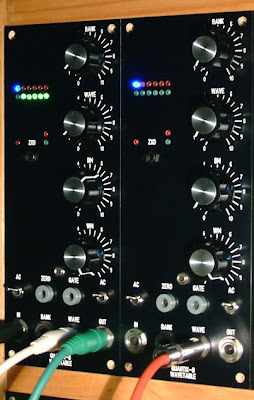 images
images via
this auction"This synth features one square and saw waveform VCO (voltage controled oscillator) with a huge pitch range, from subsonic to ultrasonic sound
One square and triangle waveform LFO (low frequency oscillator), that modulates the VCO for the vibrato effect creating old school arcade Atari-like sounds.
White noise generator that triggers the VCO and can create percussion like sounds.
8 step Sequencer with note on/off switch and pitch knob for each step
It features a 1/4 inch audio output, 1/4 inch CV Output (to control other analog gear), 1/4 inch Clock input (gate in, to sync whit an external analog clock, like another analog sequencer), 1/4 inch Gate/clock output.(to sync whit other analog gear using the Mochika's internal clock)
Also the instrument is ligthed with 2 super bright green leds that indicates the LFO and Sequencer Rate, and 8 blue ultra bright leds to indicate the step that is being played. Very useful when you play it on a dark stage.
The Analog Sequencer is packed in a cool cristal acrilic case that shows all the hand made analog circuitry.
The instrument is powered directly from 110V or 220V AC, rubber feet, and comes with operation manual.
Dimensions: 9 inch(W), 7 inch(D), 3 1/4 inch(H. incuded rubber feet and knobs)"
www.atomolabs.blogspot.com
 "The Quantix-8 module is a CV Quantizer / Wavetable Oscillator based on a 4Mbits Static RAM memory and a PIC microcontroler with a full MIDI implementation. The memory contain 2048 waveforms of 256bytes organised into a matrix of 32 Banks x 64 Waves. The Quantix-8 is a very polyvalent 7 in 1 module"
"The Quantix-8 module is a CV Quantizer / Wavetable Oscillator based on a 4Mbits Static RAM memory and a PIC microcontroler with a full MIDI implementation. The memory contain 2048 waveforms of 256bytes organised into a matrix of 32 Banks x 64 Waves. The Quantix-8 is a very polyvalent 7 in 1 module"













































